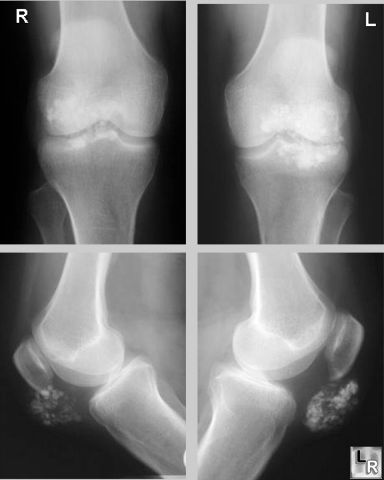|
|
Pre-patellar Bursitis
Housemaid's Knee
General Considerations
- Prepatellar bursa is superficial bursa
- Thin synovial lining
- Located between skin and patella
- Main function is to separate patella from patellar tendon and skin
- Normally does not communicate with joint
- Contains minimal amount of fluid
- Inflammation of prepatellar bursa results in marked increase of fluid in bursa
- Incidence of prepatellar bursitis greater in males than females
Causes
- Direct trauma (eg, a fall on patella or direct blow to knee)
- If acute, frequently due to small blood vessel rupture
- Repetitive minor injuries (eg, repeated kneeling)
- Septic or pyogenic process
- Infection usually from Staphylococcus aureus from break in skin
- More prevalent in children
- Can be mistaken for pyogenic arthritis
- Crystal deposition (eg, gout, pseudogout)
- Occupation
- Carpet layer
- Wrestlers
- Coal miner
- Roofer
- Plumber
- Homemaker (housemaid's knee)
Clinical findings
- Knee pain
- Swelling
- Redness
- Difficulty walking
- Relief of pain with rest
- History of repetitive motion
- History of occupation requiring excessive kneeling
- History of a fall on knee or blunt trauma to knee
Physical findings
- Patella tender to palpation
- Fluctuance over lower pole of patella
- Erythema
- Crepitation
- Decreased ROM
Imaging Studies
- Plain radiographs
- Soft tissue swelling
- Calcification
- Especially if hemorrhage into bursa
- Computed tomography (CT) scan and magnetic resonance imaging (MRI)
- Complex fluid collection anterior to knee in region of prepatellar bursa
- Wall of bursa my be thickened and irregular
Treatment
- NSAIDs
- Cortisone injection
- Aspiration of bursa
- Surgical removal of bursa
- Kneepad
- Has high recurrence rate

Prepatellar Bursitis. Frontal and lateral radiographs of both knees
demonstrate
multiple, punctate calcifications in the pre- and infrapatellar regions.
Kelly Allen, MD eMedicine.com
|
|
|